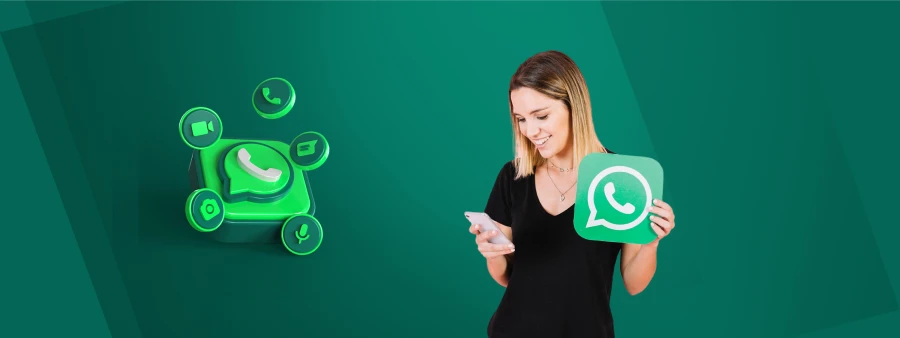Human handover: Seamlessly transfer chats to Live Agents
Co-browsing: Eliminate confusions
No-code: Build your chatbot effortlessly
Get Started for FreeNo credit card required

As a B2B marketer, you clearly understand how marketing to businesses is significantly different from marketing to individual consumers. You are aware of how marketing to a business means you target an audience that is evolved and that does in-depth research on your messages and offers. Plus, the average buying group consists of 6 to 10 decision-makers in B2B.
All this makes business-to-business marketing complex.
On the other hand, you know marketing is simpler for a B2C audience as you just need to consider individual needs, emotions, and desires. More so, immediate needs are often the biggest driving factor when you do business-to-consumer marketing.
Despite the obvious challenges, you should know how B2B marketing efforts can be hugely successful if you understand the target audience’s needs, pain points, and decision-making process.
In this blog, we will explore B2B marketing in detail, and understand the definition, strategies, funnel, tools, trends, and also look at some real-life examples from the industry.
But first, let’s get started with understanding what B2B marketing is….
B2B marketing is a short form for “business-to-business” marketing, and it refers to the marketing activities that are geared towards a business or organization. This type of marketing focuses on promoting offers and building relationships between companies rather than individual consumers.
Key features of B2B marketing –
B2B and B2C marketing are two distinct approaches to promoting and selling products and services. While both these marketing are similar at many levels, there exist some differences due to the unique target audience and the nature of the purchase decisions involved.
Some of the main differences between B2C and B2B marketing include –
The B2B marketing funnel (or the sales funnel) is a complete visual representation of the customer journey that shows all the stages, from the initial awareness to the final purchase. The main purpose of creating a marketing funnel is to outline the different stages that potential B2B clients may follow before being ultimately converted. Using the funnel, a business can know the challenges of each stage and tailor the marketing efforts in a way that helps guide prospects through all the stages.
Here are all the stages of a B2B marketing funnel –
A B2B marketing plan is a detailed roadmap developed to connect with potential business customers. It outlines the steps and strategies to sell products or services, generate leads, and drive sales. The ultimate purpose of a B2B marketing plan is to have a comprehensive strategy for reaching, engaging, and converting the target businesses into customers.
Here are the key components of a B2B marketing plan –
B2B marketing tools play a key role in connecting and engaging with your target audience, driving leads and sales, and making your business successful. These tools can offer useful insights into your target audience and make your marketing campaigns more effective. Whether you want to manage your customer database or leverage the power of your website or social media or content marketing, these tools can do all.
Here are the top B2B marketing tools and software for your business –
It’s a highly effective B2B marketing tool and is rated among the best in the category. As an all-in-one tool, it brings together inbound marketing, sales, and customer service features to help businesses engage and attract their B2B customers. Using this powerful tool, a business can hugely improve the effectiveness of its marketing efforts and convert customers.
It’s a popular B2B marketing tool that is widely used for creating and optimizing landing pages and pop-ups. Using this tool, a business can boost conversion rates and generate more leads from marketing campaigns. Its excellent A/B testing and analytics features can prove valuable in improving the conversion rate for marketing campaigns.
Ahrefs is primarily a powerful SEO tool but its tons of advanced features make it a valuable B2B marketing tool as well. Apart from the proven search engine optimization capabilities, it also offers features for driving traffic, boosting online visibility, and contributing to B2B marketing efforts. Using the tool, marketers can understand their competition, optimize their content strategy, and get key customer insights.
BuzzSumo is a quality B2B marketing tool that offers tons of features for businesses to engage with the target audience and stay ahead of the pack. Using this tool, you will get valuable insights and data that can enhance your content marketing strategies and build meaningful relationships with customers. From identifying influencers to social media monitoring to spotting trending topics, it can do a variety of tasks to support your B2B marketing efforts.
Salesforce is a very popular CRM platform that can also serve as a solid B2B marketing tool. While it’s known for customer service and sales capabilities, there are several other features and integrations that make it effective for B2B marketing efforts. Apart from managing customer relationships, it also offers features for lead management, marketing automation, campaign management, and social media engagement.
Drip is an excellent marketing automation platform that can also be used as a B2B marketing tool. It can be used for driving engagement, nurturing leads, and converting prospects into customers. Its email automation and multi-channel capabilities make it a powerful tool for optimizing marketing efforts.
More B2B companies now leverage the power of automation to streamline their marketing efforts, improve the efficiency of operations and enhance customer engagement. When B2B marketing automation tools are used, it becomes easy to generate quality leads, build awareness and achieve multi-channel engagement.
Here are some of the key benefits of using B2B marketing automation tools and software –
Choosing the right channels is vital for the success of your B2B marketing efforts. When you know the right channel, it means you’re aware of where your target audience is and thus, you can send the right message and make communication convenient. A well-rounded B2B marketing strategy combines multiple channels to engage the audience effectively.
Here are some of the most important marketing channels for your B2B business –
Using B2B marketing services will give your business access to a diverse range of marketing expertise and drive growth. From demand generation to customer outreach programs, a holistic approach will ensure that your business enriches from a comprehensive marketing strategy, resulting in measurable and impactful results.
Here are some of the ways B2B marketing services can help your business –
You need a comprehensive and targeted marketing strategy to grow your B2B business. You also need to align your B2B marketing strategies with your business objectives to reach the right audience and drive growth.
Here is a list of the 7 most effective B2B marketing strategies that will hopefully help your business grow –
Understanding the buyer’s journey is key to tailoring marketing messages and sales efforts to the specific needs and preferences of potential customers. It will help you understand the entire process through which business buyers go through before making a purchase decision. When you are aware of the B2B buyer’s journey, you can easily provide the right information, offer personalized support, and build trust. You can thus also enhance the buyer’s experience and boost the chances of successful conversions.
While a buyer’s journey gives information about potential customers, you’re still not sure who you’re marketing to specifically. You need to decide who will purchase your products or who will take the buyer’s journey. So, the key is to identify your target audience, but before that, you need to know the target market.
You need to know many things for identifying the target audience, including –
Once you get a fair idea about the target market, the next step is to understand the target audience. After all, you are going to market your products to individuals, aren’t you?
To know the target audience, you need to do many things, including –
Based on all the information you have, you can create buyer personas and customer profiles that will help you decide the right marketing strategy to target them.
What comes after you have identified your target market and target audience? Well, the next step is defining and choosing your marketing mix. It means you need to specify your 4Ps of marketing so that you can tailor your marketing strategy effectively.
Source
Here are the 4 Ps of B2B marketing –
In order to create a more robust marketing strategy, you first need to define your 4 Ps as it has all the information regarding your product and customer. From this stage, you can move on to the execution part of a more effective strategy.
You now move to the stage of creating a marketing plan which will work as a detailed roadmap to connect with potential business customers. This plan will have all the steps and strategies to sell products or services, generate leads, and drive sales. It will give you a comprehensive strategy for reaching, engaging, and converting the target businesses into customers.
When you create a marketing plan, you first need to do market research into the pain points and challenges of the target market followed by setting measurable goals. In this stage, you will craft value proposition messaging and settle on lead generation & nurturing activities. You will set a budget and timelines and then measure the effectiveness of the efforts.
When you’re in the B2B market, the key to success is to know what your competitors are up to and what is ticking for them. Running a competitive analysis will also give you a good idea about whether your marketing strategies could be as effective.
Now when you have run a competitive analysis, you would have a fair idea of how to position your brand in the market. You will have understood how to align the brand’s identity with the needs and perceptions of your target audience.
To determine your brand positioning, you need to do the following –
The current B2B marketing landscape is more complex than it has ever been before. Marketers are witnessing newer challenges that are refining the market in a big way. With the focus gradually shifting to leveraging the most advanced tools and technologies around, it was only a matter of time before the traditional boundaries stood shaken. All this has led to the emergence of top trends.
In recent times chatbots have become a vital element in B2B marketing as they offer several benefits to businesses. Whether a business wants to engage with its audience or provide personalized support, bots can handle all with ease. More so, well-designed chatbots with AI capabilities have transformed the way marketing is done in the B2B market.
Many B2B firms now understand the potential of podcasts to reach their audience and connect with them in an engaging manner. With marketing podcasts, marketers find a medium to share thought leadership and showcase their offerings to the target audience. More so, this channel gives the opportunity to connect with the audience on a deeper level. The best part, 4 out of ten top leaders, department heads, VPs, and owners listen to podcasts, making it a very beneficial channel for marketing.
As a B2B marketer if you think video marketing has saturated as a channel, think again. This channel has way more to give than you could imagine. Your target audience laps up quality videos and they are in no mood to change their taste anytime soon. More brands look to leverage the power of YouTube and Vimeo platforms as they know that the thirst for visual content is huge.
More B2B marketers now realize the benefits of targeting specific accounts rather than chasing a broader audience. This realization is the reason fuelling the growth of account-based marketing (ABM). With this approach, brands can tailor their content and messages to specific needs, resulting in higher conversion rates. All this is the reason why ABM is also driving a more personalized experience for the target audience.
While most brands are aware of the power of content in engaging and connecting with the target audience, not many are able to tap into that. Mailchimp is an exception though as it knows how to use the content to keep the target audience hooked and up-to-date on the latest trends.
Mailchimp’s Briefings section does not focus on just creating content around email marketing, but it chooses topics that could interest the wider tastes of the audience who could potentially use Mailchimp for their email marketing campaigns.
There is no denying the fact that influencer marketing is now a big part of the B2B marketing mix and the chances of success are greater when you find the right influencers. When one of the world’s top electronics companies, Philip, can bet big on influencers, it means this marketing channel has more potential than imagined.
It first created a digital command center and then tracked three groups of social users, including the “influencers” for engagement purposes. This helped reduce the marketing spend and achieve better ROI.
Marketing is all about reaching the target audience, piquing their curiosity about your products, and raising their interest in your brand. To achieve these goals, brands have their own unique ways but what Canva did is truly remarkable – it chose to show people the power of its tool and this strategy worked big time.
Its Canva Events include webinars, workshops, and Q&A sessions that center around using its products and doing all the amazing things.
For a logistics company, you’d assume that it has limited ideas about how to market the brand. But if the company is FedEx, you know it can turn the logic upside down and it did in a remarkable manner. It chose to make a big splash on social media and the strategy paid rich dividends. The best part, it ensured an immersive travel experience for its followers by using various photos showing Fedex in exotic locations and all that turned their social feed into a travelog.
Effective B2B marketing is all about combining the best tools and technologies to connect with the audience and convert. At REVE Chat, we realize the value of using the power of technology to boost connections and drive conversions.
We have a variety of support and engagement tools that a B2B business can use and enhance its marketing efforts. Our AI-powered chatbot can help automate various tasks across sales, marketing, and support.
More so, using our video chat software and co-browsing software can help brands provide the best visual support to clients. Plus, our live chat software can be paired with the chatbot to provide hybrid support and enhance the user experience at each stage of their journey.
B2B marketing may be challenging but a clear strategy and the right tools can make it incredibly rewarding for your business.
With REVE Chat, you can find the best engagement and support tools to get value out of your B2B marketing efforts.
So, you can sign up here and see how our products can add value to different aspects of your marketing endeavors.
Start a 14-day free trial, no credit card required
Stay updated with the latest trends and ideas we share

What if you could use a channel that helps you reach your customers instantly and directly anytime you like? On...

Businesses face numerous challenges in reaching and engaging their target audience effectively. How can you make the process easier to...

Traditional banks are transitioning into digital banks, with artificial intelligence in banking becoming increasingly popular. Approximately 35-40% of banks are...